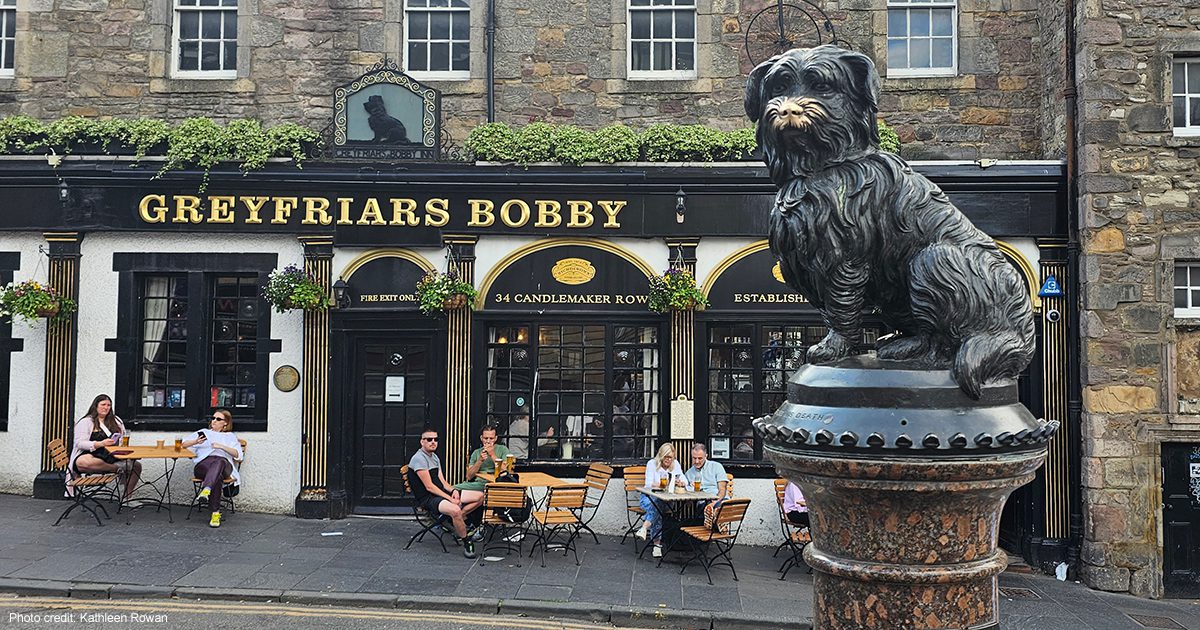
Jun 26, 2023 Greyfriars Bobby
As so often happens when visiting a city such as Edinburgh in Scotland, one finds oneself overwhelmed, exhausted, and in my case, lost. Edinburgh, the Scottish capital since the 15th century, is steeped in history, with tall, dark buildings and spires, natural beauty, and an almost mystical feel. Furthermore, Edinburgh’s Old and New Towns have been deemed worthy of a UNESCO listing as a World Heritage site. J. K. Rowling, the author of the Harry Potter series, lives in Edinburgh, and her books are infused with the mystical essence of Edinburgh. Given the city’s vibrancy and meandering streets, I rationalize that many other people have also lost their way.
At some point in my wanderings from the castle, I encountered a group of people standing around a small statue. After fumbling with my phone GPS and turning my “can’t miss it” map in several directions, I asked a kind person what was going on and why people were rubbing the nose of a statue. After a pitying glance at me, I was told that John Grays’ Bobby, a Skye Terrier, is memorialized here. I responded, “Of course.” Returning to my multipurpose phone, I read the legend about this Skye Terrier, or possibly a Dandie Dinmont Terrier, named Bobby.
According to legend, John Gray, a gardener, came to Edinburgh in 1850 with his wife and son but could not find work. To avoid ending up in a workhouse, Mr. Gray joined the Edinburgh City Police as a night watchman. An extraordinary (or perhaps a typical) relationship between a man and a dog began during his time as a night watchman. John acquired a partner, a diminutive Skye Terrier and ‘watchdog’ called Bobby, who kept him company through the long winter nights. Together John and Bobby became a familiar sight trudging through the cobbled streets of Edinburgh. Through thick and thin, winter and summer, they were faithful friends. The view of the two walking the streets of Edinburgh was a comfort to the citizens of Edinburgh. John and Bobby developed the habit of dining at a coffee house where Bobby would be given a free meal.
John Gray died in 1858 of tuberculosis and was buried in Greyfriars Kirkyard, a cemetery surrounding the local Greyfriars’ parish church. Bobby reportedly watched his best friend’s grave for close to 14 years despite attempts to lure him from the grave by the gardener and keeper of Greyfriars. When Bobby refused to move, shelter was provided for Bobby near Gray’s grave. It was reported that crowds would gather in front of the graveyard and wait for Bobby to leave for his one o’clock meal at the same hostelry he frequented with John Gray. Bobby died on January 14, 1872, and is buried inside Greyfriars Kirkyard cemetery near his best friend, John Gray.
Today, the statue of Bobby can be found at the intersection of George IV Bridge and Candlemaker Row. Admirers have rubbed the nose of his statue so often for luck that the nose is now a shiny brass beacon. However, the caretakers of his memorial discourage touching the statue to preserve the statue’s structure. I also rubbed Bobby’s nose for good luck, but only before I knew such touching was officially discouraged.
Stories of people and animals and their devotion to each other are heartwarming and reflect caring in their purest form. We could do with more heartwarming relationships like the one Bobby and John Gray enjoyed.
________________________________________________________________________
In keeping with WBI’s commitment to transparency and accountability, we feel compelled to report on several alternative interpretations of the events reported in this article. Some have argued that Bobby was not a Skye Terrier but a Dandie Dinmont Terrier (more common in Edinburgh than Skye Terriers). There was also reportedly more than one Bobby during this period. The local landlord had an economic incentive to keep the crowds coming to observe Bobby, and it has been suggested that “Bobby” may have lived longer than is typical for a small terrier. We at WBI have chosen to believe the version of the tale reported in the body of this article.


